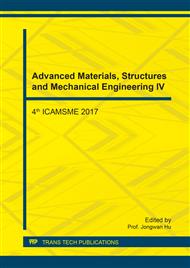[1]
M. Shirzadegan, et al. Low degree of freedom approach for predicting friction in elastohydrodynamically lubricated contacts. Tribol. Int. 94 (2016) 560-570.
DOI: 10.1016/j.triboint.2015.10.010
Google Scholar
[2]
I. Krupka, P. Sperka, M. Hartl. Effect of surface roughness on lubricant film breakdown and transition from EHL to mixed lubrication. Tribol. Int. 100 (2016) 116-125.
DOI: 10.1016/j.triboint.2015.12.008
Google Scholar
[3]
P. R. Yang. Numerical analysis of fluid lubrication. Beijing National Defence Industry Press, Beijing, (1998).
Google Scholar
[4]
A. A. Lubrecht, W. E. T. Napel, A. R. Bosm. Multigrid, an Alternative Method for Calculating Film Thickness and Pressure Profiles in Elastohydrodynamically Lubricated Line Contacts. ASME J. Tribol. 108(4) (1986) 551-556.
DOI: 10.1115/1.3261261
Google Scholar
[5]
F. Guo, P. Wong. A multi-beam intensity-based approach for lubricant film measurements in non-conformal contacts. Proc. Inst. Mech. Eng. Part J: J. Eng. Tribol. 216(5) (2002) 281-291.
DOI: 10.1243/135065002760364822
Google Scholar
[6]
O. Marklund, L. Gustafsson. Interferometry-based measurements of oil-film thickness. Proc. Inst. Mech. Eng. Part J: J. Eng. Tribol. 215(3) (2001) 243-259.
Google Scholar
[7]
D. Košťál, et al. Lubricant Rupture Ratio at Elastohydrodynamically Lubricated Contact Outlet. Tribol. Lett. 59(3) (2015) 1-9.
DOI: 10.1007/s11249-015-0565-7
Google Scholar
[8]
X. Jiang, P. L. Wong, Z. Zhang, Thermal Non-Newtonian EHL Analysis of Rib-Roller End Contact in Tapered Roller Bearings. J. Tribol. 117(4) (1995) 646-654.
DOI: 10.1115/1.2831530
Google Scholar
[9]
T. Sakaguchi, K. Harada, Dynamic Analysis of Cage Stress in Tapered Roller Bearings Using Component-Mode-Synthesis Method. J. Tribol. 131(1) (2008) 011102-011102-011109.
DOI: 10.1115/1.3002326
Google Scholar
[10]
Z. Liu, A. Gangopadhyay, Friction Reduction in Lubricated Rough Contacts: Numerical and Experimental Studies. J. Tribol. 138(2) (2015) 021506-021506-021512.
DOI: 10.1115/1.4031752
Google Scholar
[11]
W. Holzhauer, J. R. Gnagy, R. D. Evans, Factors Affecting Surface Roughness Measurement Results, and the Impact on Predicted Life of Elastohydrodynamic Lubricated Rolling-Element Bearings. J. Tribol. 138(4) (2016) 041501-041501-041507.
DOI: 10.1115/1.4032790
Google Scholar
[12]
A. A. Lubrecht, W. E. T. Napel, R. Bosma. Multigrid, an Alternative Method of Solution for Two-Dimensional Elastohydrodynamically Lubricated Point Contact Calculations. J. Tribol. 109(3) (1987) 188-188.
DOI: 10.1115/1.3261563
Google Scholar
[13]
P. Svoboda, et al. Study of Scale Effect in a Starved Elastohydrodynamically Lubricated Contact. Appl. Mech. Mater. 821 (2016) 138-143.
DOI: 10.4028/www.scientific.net/amm.821.138
Google Scholar
[14]
P. Lugt, G. E. Morales Espejel. A review of elasto-hydrodynamic lubrication theory. Tribol. Trans. 54(3) (2011) 470-496.
DOI: 10.1080/10402004.2010.551804
Google Scholar


